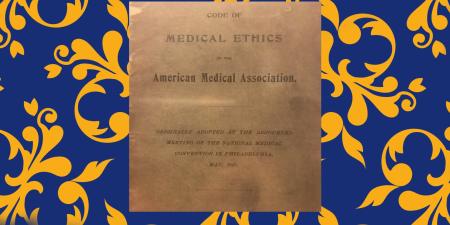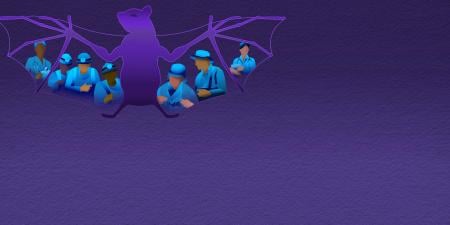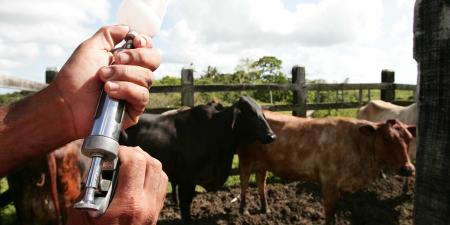Abstract
Consumption and trade of wild animals presents major zoonotic disease transmission risks. Policies that aim to limit these practices must balance environmental health against the fact that trade and consumption of wild animals are important sources of livelihood and food security for many people. This commentary on a case suggests how public health threats posed by the wild animal trade, wet markets, and bushmeat practices might guide policies and actions of relevant stakeholders. A One Health approach is offered to navigate competing interests and balance ethical concerns.
Case
Dr M is an official in the Ministry of Health preparing to meet health officials from neighboring areas to consider policy strategies for regulating regional live wild animal capture and trade and wet market and bushmeat practices. In the wake of such practices’ roles in SARS-CoV-2, influenza, and Ebola virus transmission from nonhumans to humans,1 health officials remain concerned that emerging pathogens from reservoir or vector species pose threats to individuals living in the Global South in under-resourced communities for whom practice changes could mean exacerbated poverty and food scarcity. Dr M and colleagues consider how to weigh risks and benefits of practice changes2 and how quickly policies guiding key practice changes likely to mitigate zoonotic transmission should be enforced.
Commentary
Dr M is rightly concerned about the roles that the wild animal trade and wild animal consumption play in increasing the risk of emerging pathogens and the spread of zoonotic diseases. The rise in globalization, including encroachment on wildlife habitat and expanded trade and travel networks, has increasingly brought humans into contact with animals that serve as reservoirs for infectious diseases. In particular, the recent expansion of the global wildlife trade and consumption of wildlife, which brings humans into direct and indirect contact with wild animals, has created an unprecedented situation for the scale and speed of zoonotic pathogen movement.3,4 It is estimated that up to 75% of all emerging infectious diseases are zoonotic and that nearly 72% of zoonotic diseases originate in wild animals.3,5 Recent examples of zoonotic diseases include Ebola, bird flu, Mpox, and COVID-19.4,5
Because zoonotic diseases emerge at the human-animal-environment interface, it is widely thought that successful control measures require a One Health approach.1,3,4,5,6 One Health recognizes that the health of humans, animals, and the environment are all interrelated and encourages collaboration among diverse stakeholders to improve public health.6 With respect to reducing the risk of zoonotic disease transmission, a One Health approach entails collaboration among various authorities and agencies, including those responsible for human health, veterinary health, agriculture and food safety, wildlife management, forestry, and other environmental agencies.1,6 Given Dr M and colleagues’ need to balance public health and economic concerns, they should adopt a One Health approach as they determine their policy recommendations.
Scope of Policy
Dr M is considering policy recommendations for 3 specific aspects of the wildlife trade: (1) live wild animal capture and trade, (2) wet markets, and (3) bushmeat practices. Dr M hopefully recognizes that these aspects of the wildlife trade are distinct and thus must be clearly defined so that specific policies can be designed and implemented for each.
Live wild animals captured and traded refer to those caught and sold not for consumption and those animals intended for consumption but not butchered until purchased at a wet market. While there is great diversity in the species of wild animals caught and traded, research suggests that only a few wild animal groups tend to host a high number of zoonotic pathogens.7 Shivaprakash et al propose that policy designed to mitigate zoonotic disease transmission from wild animals should focus on preventing the trade of animal groups with high pathogenic load, specifically “rodents, bats, primates, ungulates, carnivores, and marsupials.”7
Lin et al distinguish animal markets along 3 dimensions: live-animal markets, wildlife markets, and wet markets.8 Live-animal markets include those selling live domesticated animals and live wild animals for both consumption and non-consumption. Wildlife markets concentrate only on the trade of wild animals, which may be either alive or dead, and may be intended for either consumption or non-consumption. Like the wildlife trade itself, wet markets are incredibly diverse, ranging in size, products offered, and level of legal and regulatory oversight. Wet markets, named for their frequently wet floors due to the washing of stalls to keep them clean and “the melting of the ice used to keep foods fresh,” can range from markets “selling just fruits and vegetables, to those selling wild-caught (and possibly endangered) wildlife”—that may be alive or dead and domesticated or wild—for consumption.8 Lin et al identify 6 key characteristics of animal wet markets that increase the risk of zoonotic disease transmission: animal taxa at high risk of being disease carriers, the presence of live wild animals, poor hygiene practices by vendors, larger markets that serve larger numbers of people, high animal density and interspecies mixing, and lengthy supply chains.8
Bushmeat practices refer to the harvesting of wild animals, legally or illegally, for consumption. Mammals make up the majority of animals harvested as bushmeat in terms of both number and biomass, with ungulates and rodents being most common.2 Much of the urban bushmeat trade occurs in open markets, although a substantial amount of bushmeat also passes through more informal channels. While this demand is often driven by wealthy individuals who view bushmeat as a luxury item, in poorer rural areas around the world there are also many people who rely on bushmeat for their livelihood as well as for food security.2,8
Hilderink and Winter identify 4 phases of the wildlife trade wherein risks of zoonotic spillover emerge: (1) hunting, trapping, and butchering; (2) transportation; (3) sale; and (4) consumption and use. They explain: “Given that those zoonotic pathogens spread through various transmission pathways, sometimes multiple pathways at the same time, e.g., through (in)direct physical contact, bodily fluids, and faecal-oral, foodborne, and airborne transmission, a single trade activity can have a drastic impact on the spread and amplification of zoonoses.”3 Dr M and other policy makers thus need to recognize the importance of regulation at each phase of the wildlife trade, from capture to consumption, while at the same time taking into account the ways this trade supports the livelihoods and nourishment of many individuals. The One Health approach that Dr M and colleagues should embrace must also engage all relevant stakeholders to ensure that policies are put in place that focus not only on prevention of disease transmission but also on equity.
Reducing Zoonotic Transmission Risk
Given the fact that the wild animal trade, like zoonotic disease emergence and transmission, exists in a diverse range of settings, it is clear that generalized one-size-fits-all policies will not be effective interventions.9 In the wake of the COVID-19 outbreak, for example, there were calls for outright bans of wet markets, but such extreme measures are generally regarded by experts as misguided.10 Bans are difficult to enforce and tend to drive the sale of wild animal products underground where they are harder to monitor and regulate.9,11 Instead, there is general agreement that policies to intensify regulation, monitoring, and enforcement work better to reduce health risks associated with demand for and consumption of wild animals.10
Bans are difficult to enforce and tend to drive the sale of wild animal products underground where they are harder to monitor and regulate.
As Dr M and colleagues weigh the risks and benefits of policies for regulating live wild animal capture and trade, wet markets, and bushmeat practices, they will need to consider the various phases of the wildlife trade and types of wet markets and recognize that a variety of different policies will be needed due to the complex and dynamic nature of the wild animal trade. These policies should include those that target individuals through educational campaigns, engage communities in conservation efforts, and improve sanitation and oversight of the trade and sale of wild animals, as well as policies directed at the national and international level to improve zoonotic disease surveillance and reduce the risk of zoonosis from the international wildlife trade. This work will require collaboration among a variety of authorities, agencies, and stakeholders, both within and across countries.
Public health campaigns targeting individuals should be developed to educate people about zoonotic diseases and the dangers of consuming meat from wild animals and to educate and train those who work within the wild animal trade in proper food safety and sanitation.3,7,11 Conservation and community-outreach programs should be developed both to reduce interactions at the human-wildlife interface and to ensure that such measures are implemented in an equitable manner that balances ecological and biodiversity conservation with food security and the support of community livelihoods.2,3 Effective efforts include creating protected areas or land sharing, agroforestry practices, and alternative livelihood opportunities to the wild animal trade, such as ecotourism, community-led anti-poaching, or wildlife stewardship efforts.2,3
Government policies that target transportation and sale of wild animals should focus on sanitation and oversight and should likely include stringent hygiene standards in traditional food markets, regular ante- and postmortem inspections at the time of slaughter, separate hygienic areas for slaughter and dressing that are away from the public and other live animals, regulations to prevent species mixing and reduce overcrowding, surveillance for early detection of disease, and monitoring of zoonotic disease in import and export animals and of food processing facilities and employees.3,5,6,7,12
Government policy should also focus on reducing global wild meat consumption.While targeted bans on animals most likely to be zoonotic disease vectors have been proposed as alternatives to general bans, even selective bans are likely to drive trade underground.8,11 An alternative to targeted bans might be targeted restrictions. For example, one 2020 modeling study found that increased international restrictions on the trade of wild animals resulted in a decrease in the estimated volume of animals traded and thus a decrease in the estimated volume of potential zoonotic disease transported.4 A crucial element in limiting zoonotic disease transmission, however, is development of an international metagenomic pathogen discovery and surveillance system to identify new and emerging diseases.5,7
Policy makers like Dr M need to develop strategies that are heterogeneous, local, and created in consultation with local communities.3,8 An example of such a strategy might be targeted bans of high-risk animals but only within large, urban wet markets, thereby creating greater flexibility for those whose livelihoods depend on the rural bushmeat trade.
Balance
In general, policy makers such as Dr M and colleagues should focus on minimizing harmful disruptions to communities while prioritizing regulating markets that trade in wild animals, which pose the greatest risk of zoonotic disease transmission.8 Reducing the risk of zoonotic disease transmission that the wild animal market engenders will require a cooperative One Health approach that brings together wildlife experts, national and international legislators, conservation organizations, and communities and will require coordinated surveillance at all levels, local to international.3,6 It is important to recognize that these policy improvements will be costly and that developing countries will likely need financial assistance. Dr M and colleagues will thus need to discuss the economic feasibility of such policies and secure funding to ensure that the development of policies and programs is done equitably for individuals and countries.
References
-
World Organisation for Animal Health; World Health Organization; United Nations Environment Programme. Reducing public health risks associated with the sale of live wild animals of mammalian species in traditional food markets: interim guidance. World Health Organization; 2021. Accessed July 1, 2023. https://cdn.who.int/media/docs/default-source/food-safety/ig--121-1-food-safety-and-covid-19-guidance-for-traditional-food-markets-2021-04-12-en.pdf?sfvrsn=921ec66d_1&download=true
-
Cawthorn DM, Hoffman LC. The bushmeat and food security nexus: a global account of the contributions, conundrums and ethical collisions. Food Res Int. 2015;76:906-925.
-
Hilderink MH, de Winter II. No need to beat around the bushmeat—the role of wildlife trade and conservation initiatives in the emergence of zoonotic diseases. Heliyon. 2021;7(7):e07692.
- Borsky S, Hennighausen H, Leiter A, Williges K. CITES and the zoonotic disease content in international wildlife trade. Environ Resour Econ. 2020;76(4):1001-1017.
- Naguib MM, Li R, Ling J, Grace D, Nguyen-Viet H, Lindahl JF. Live and wet markets: food access versus the risk of disease emergence. Trends Microbiol. 2021;29(7):573-581.
-
Rahman MT, Sobur MA, Islam MS, et al. Zoonotic diseases: etiology, impact, and control. Microorganisms. 2020;8(9):1405.
- Shivaprakash KN, Sen S, Paul S, Kiesecker JM, Bawa KS. Mammals, wildlife trade, and the next global pandemic. Curr Biol. 2021;31(16):3671-3677.e3.
- Lin B, Dietrich ML, Senior RA, Wilcove DS. A better classification of wet markets is key to safeguarding human health and biodiversity. Lancet Planet Health. 2021;5(6):e386-e394.
- Barnett T, Fournié G. Zoonoses and wet markets: beyond technical interventions. Lancet Planet Health. 2021;5(1):e2-e3.
-
Standaert M. “Mixed with prejudice”: calls for ban on “wet” markets misguided, experts argue. The Guardian. April 15, 2020. Accessed October 24, 2024. https://www.theguardian.com/environment/2020/apr/15/mixed-with-prejudice-calls-for-ban-on-wet-markets-misguided-experts-argue-coronavirus
- Aguirre AA, Catherina R, Frye H, Shelley L. Illicit wildlife trade, wet markets, and COVID‐19: preventing future pandemics. World Med Health Policy. 2020;12(3):256-265.
- Petrikova I, Cole J, Farlow A. COVID-19, wet markets, and planetary health. Lancet Planet Health. 2020;4(6):e213-e214.



